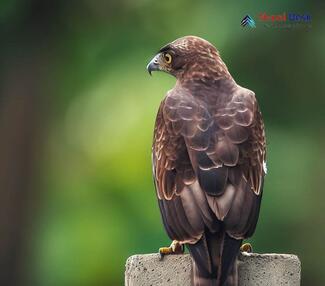Nepal's rich biodiversity is home to the captivating Crested Honey Buzzard (Pernis ptilorhynchus), a bird of prey that has enthralled nature enthusiasts and bird lovers alike with its regal appearance and unique hunting skills. Often mistaken for a short-toed snake-eagle in flight, this fascinating creature is not related to Buteo buzzards, but rather shares a taxonomic connection with kites. Belonging to the Accipitridae family, which includes many diurnal raptors such as eagles and harriers, the Crested Honey Buzzard is also known as the Oriental, Asiatic, or Eastern honey buzzard. The name stems from its primary diet of bee and wasp larvae extracted from honeycombs. Let us explore the various facts and details of this incredible species through this article:
A regal presence in the skies
The Crested Honey Buzzard, as its name suggests, has a unique crest on its head that resembles a crown. The bird’s plumage can vary from shades of brown to gray, with intricate patterns mirroring the textures of tree bark or foliage. This remarkable camouflage allows the bird to seamlessly blend into its environment, evading detection from both predators and prey.
An exceptional hunter with a sweet tooth
While it's primarily known for feeding on honeycombs and bee larvae, the Crested Honey Buzzard exhibits extraordinary hunting techniques to catch diverse prey. In addition to consuming bees and wasps, these birds are opportunistic hunters, preying on small mammals, reptiles, and even other birds. The Crested Honey Buzzard has developed remarkable immunity against bee and wasp stings, allowing it to comfortably raid their nests.
The feeding habits of Crested Honey Buzzards largely contribute to maintaining the ecological balance in their habitat. By preying on bees and wasps populations, they help control insects that could potentially harm vegetation in the surrounding areas.
Discovering the ideal habitat
In Nepal, the Crested Honey Buzzard is commonly found in forests lying within lowland plains and subtropical regions. They prefer habitats with a combination of mature trees and dense understories near open areas like farmlands, rivers, and wetlands. National parks and wildlife reserves, such as Chitwan National Park and Parsa Wildlife Reserve, have become sanctuaries for this elusive bird.
An unforgettable sighting experience
Witnessing a Crested Honey Buzzard in its natural habitat can be a mesmerizing experience for bird enthusiasts. Their stealthy movements and camouflage make them challenging to spot, adding an element of excitement to every sighting. For the best chance to witness these incredible birds in action, consider participating in guided birdwatching tours with experienced naturalists who understand their behavior and preferred habitats.
In conclusion, the Crested Honey Buzzard is undoubtedly a remarkable gem among Nepal's diverse bird population. Its regal appearance, unique feeding habits, and exceptional hunting techniques add charm and intrigue to the natural wonders that this country already possesses. The Crested Honey Buzzard acts as a testament to Nepal's fascinating biodiversity that awaits exploration from enthusiastic bird lovers and nature admirers alike.




